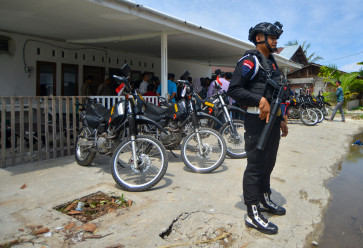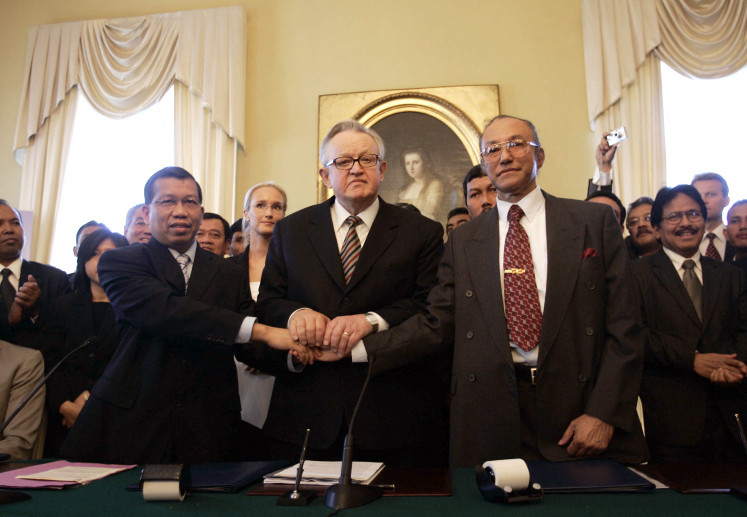Popular Reads
Top Results
Can't find what you're looking for?
View all search resultsPopular Reads
Top Results
Can't find what you're looking for?
View all search resultsLesson learned from soybean cultivation in the US
Soybean is a strategic commodity for Indonesiaâs food security, besides rice and maize
Change text size
Gift Premium Articles
to Anyone
S
oybean is a strategic commodity for Indonesia's food security, besides rice and maize. Its shortage could trigger economic and political instability as, for many Indonesians, especially low-income groups, soybean is a popular supplement for rice, the national staple food. Soybean is the main raw material for tofu, tempeh and sweet soy sauce, which provide affordable protein sources for the impoverished.
No wonder, then, that the government has always been concerned over any shortage in the supply of soybeans or steep rises in their price, as has happened over the last few weeks as a result of the sharp rupiah depreciation.
The problem, though, is that the country has always been heavily dependent on imports to fulfill its domestic demand for soybeans. According to Central Statistics Agency (BPS) data, soybean imports in the first seven months alone amounted to 1.09 million tons, of which 90.50 percent was imported from the United States and the remainder from Argentina, Malaysia, Canada, Paraguay, Ethiopia, Ukraine, Uruguay, China and Myanmar.
Unfortunately, the increasing demand for oilseed including soybeans for biodiesel production in exporter countries like the US has reduced their export supply. Moreover, the long drought in the US cut output, consequently causing the world price to soar, having a double impact on soybean prices in Indonesia due to the weakening rupiah against the US dollar.
Despite soybeans' strategic role in national food security, soybean production in Indonesia has declined steadily from 1.87 million tons in 1992 to an estimated 847,160 tons this year.
The fall in production was caused mainly by the decrease in harvested areas from 1.67 million hectares in 1992 to 571,560 hectares in 2013.
The decrease in the harvested soybean acreage was caused by the small profit margin farmers got from this crop compared to other food crops, such as rice and maize. The Cost Structures of Food Crops Production survey conducted by the BPS in 2011 showed that farmers only made 1 percent in profit from the total Rp 9.8 million farmers spent on each hectare of soybeans. Assuming the price was Rp 7,200 (63 US cents) per kilogram, farmers earned a mere Rp 86 per kg of production or Rp 118,000 ($11) per hectare.
In 2011, the highest proportion of production costs was for labor, amounting to as much as Rp 5 million per hectare for one planting season or more than 50 percent of the total production costs per hectare.
The second- and third-largest portions of the costs went on land rents and fertilizers, amounting to Rp 2.15 million (22 percent) and Rp 1.1 million (11 percent), respectively. The remainder went on other production necessities, such as seeds, pesticide and other services.
In addition, soybeans are highly vulnerable to climate change. The crop can easily be damaged by too much or too little water. Another reason why farmers have been reluctant to plant soybeans is the difficulty to get good seeds. The government does provide subsidies for soybean seeds, but bureaucratic red tape often delays the delivery of seeds to the farmers. Seeds often reach farmers only after the planting season ends; therefore, many farmers have decided to cultivate other crops.
Besides the slim profit margin, vulnerability to climate change and problem with seed delivery, the government's preference for rice crops has also contributed to the decrease in the harvested acreage of soybeans in Indonesia. The problem is that rice and soybeans are grown on the same irrigated land. Maize seems more popular than soybeans because it can be grown in rain-fed land.
It is interesting to learn how the US promotes its soybean production. According to the Electronic Report from the Economic Research Service (US Department of Agriculture, 2002) the most productive soybean production was in the country's heartland with an average yield of 45 bushels per acre or equivalent to around three tons per hectare. The region is especially suited to soybean production due to its favorable climate, soil, topography and efficient transportation systems. In addition, production costs in that region were only $2.92 per bushel or equivalent to 11 cents per kg, much lower than the 71 cents per kg in Indonesia.
However, the cost structure of soybean production in the US is vastly different from Indonesia. In the US, the largest portion of costs, 35.2 percent, goes on machinery and equipment, resulting in very high yields. Meanwhile, the cost for hired labor is only $1.25 per acre or less than 1 percent. Hence, US soybean farmers can earn a profit of as much as $162.21 per acre ' equivalent to $400.83 per hectare ' while soybean farmers in Indonesia, with yields of less than 1.5 tons per hectare, only earn $11.8 per hectare. How can they compete with imported soybeans?
Learning from the cost structures of soybean production in the US and in Indonesia, it can be concluded that farm mechanization would be an effective solution. Soybean farmers in Indonesia need to reduce their labor costs. If farmers can cut down their labor costs by 20 percent, the break-even point could be as low as Rp 6,750 per kg, which is much lower than Rp 7,000, the local soybean price floor regulated by the Trade Ministry.
Another feasible solution would be for the government or state companies to assume the role of farmers in cultivating soybeans on large estates. Such an investment would be worthwhile, given the vital role of this food crop as one of the nation's staples.
The writer is the head of evaluation and reports on food crops statistics at the Central Statistics Agency (BPS). The opinions expressed are his own.










